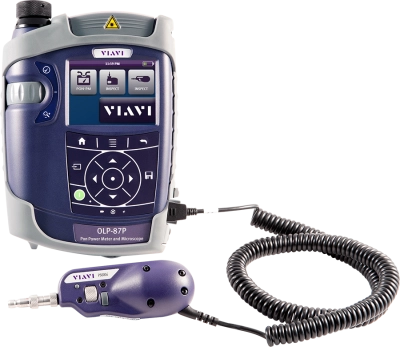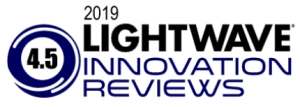The OLP-87 is an FTTx/PON power meter for use in activating and troubleshooting B-PON, E-PON and G-PON and next generation high speed 10G PON such as XG-PON and 10G-EPON networks, and higher capacity NG-PON2 networks. The OLP-87 combines a high-performance wavelength-selective power meter with pass/fail fiber inspection analysis capability into one portable solution.
Benefits of the VIAVI PON Power Meter:
- Integrates fiber inspection and test for an efficient easy-to-use solution that promotes best practices for handling fiber.
- Easily measures PON power and automatically certifies fiber-end face condition
- Generates certification report that prove that work quality meets industry standard or customer specifications
- Hands-free carrier for easy use inside homes or up on telephone poles
- Future proof, supports co-existence of PON services, e.g. deploying XG(S)-PON and/or NG-PON2 on existing G-PON networks
PON Power Meter Applications:
- Service activation and troubleshooting
- Simultaneous power measurement of all upstream & downstream wavelengths on live PON networks
- Supports tests in B-PON, E-PON, G-PON and XG-PON/10G-EPON networks
- Network activation/testing as part of 5G deployments
Key Features of the OLP-87 PON Power Meter:
- Through-mode capability for simultaneous measurement and display of voice, data and RF video signals on fiber at 1490/1550/1577nm downstream and 1270nm/1310nm upstream for B/E/G/XG(S)/10G
- Individual, wavelength selective, through mode power level measurement for multiple NG-PON2 downstream and upstream channels
- Burst mode measurement for 1270nm, 1310nm and 1535nm upstream signals
- High performance broadband power-meter option
- Up to 10.000 measurement results storage downloadable through USB or Ethernet interfaces
- Automated pass/fail fiber inspection analysis with optional P5000i microscope Integrated patchcord microscope version available
What is a PON Power Meter?
A PON power meter is a dual band or wavelength selective optical power meter designed specifically for use on PON/FTTH networks. These meters are specifically designed for use during the network activation and service installation/activation phases of the network lifecycle. PON power meters have the ability to recognize and measure optical power for individual PON services, specifically measuring the optical power of the downstream wavelengths, for example G-PON or XGS-PON. In addition, PON power meters also support the co-existence of services on the same Passive Optical Network. Co-existence is where multiple services are being delivered over the same network, for example G-PON and XGS-PON or E-PON and 10G-EPON. A PON power meter can isolate each downstream wavelength and provide a clear optical power measurement for each service/wavelength.
Why do you need a PON Power Meter?
Based on market pressures and demand from subscribers, service speeds are increasing. In order to keep up, network operators and service providers are now looking towards higher capacity/speed technologies to help, and are making the move towards deploying the 10G services like XGS-PON and 10G-EPON. Where you have new PON networks it’s reasonable to assume that they will now just jump directly to the 10G services, however, for existing networks where there are already G-PON or E-PON services, running there will have to be a migration. It's not possible to switch off the current services and move to 10G overnight. This would only be possible if you can coordinate a CPE (ONT) switch-out in all customers’ homes overnight, as well as the OLT switch over in the local/central office, and with a guarantee that there will be no hiccups with migrating the service provisioning. Plus, some customers may not want to be upgraded just yet so it's crucial to phase a migration and have both G and XGS-PON services operating on the same PON.
Traditional power meter tools like broadband power meters simply cannot be used in these co-existence scenarios. The reason is because of the way they are designed and the way they operate cannot separate individual service wavelengths. In fact, what they will do is sum together all wavelengths presented to their input (measurement port) and will give an inaccurate (and typically high) power level measurement. This can lead to extra unnecessary optical attenuation being added to reduce power levels to a range acceptable for the CPE (ONT/ONU) devices. Unfortunately, attenuators reduce optical power for all service wavelengths which then results in CPE devices that won’t activate service due to power levels now being too low, or borderline installs where service can suddenly cut out.
If there is only one service present on a PON you might be forgiven for thinking you are in the clear and can go back to using your broadband power meter, or even not bothering with any test or measurement, but how do you know which service is actually present? Is it G-PON or XGS-PON? You need to know as this will determine what type of CPE (ONT/ONU) gets installed. If the wrong CPE is chosen and installed, the device will never activate, and the customer will be without service. A PON power meter is necessary as it will indicate which wavelength/service is present where a broadband power meter will not.
Additional Resources:
Brochures
Data Sheets
Quick References
Selection Guides
Services
White Papers & Books
- Challenges in Next-Gen PON Deployment
- Fiber in 5G Networks
- Reference Guide to Fiber Optic Testing: Volume 1
- Reference Guide to Fiber Optic Testing: Volume 2
- Test Guide to DAA Planning Deployment & Maintenance
- Testing 5G: Tools and Techniques for Successful Implementation, Maintenance and Monetization
- The Perils of Using a Broadband Power Meter in a Multi-Service PON World
Software Download
Video
Care Support Plans
| Product Group | Recommended Plan | Bronze | Silver | Maxcare | |
|---|---|---|---|---|---|
| SmartClass Fiber (OLP-87/OLP-88) (PON Power Meters) | Silver-5 | Does the product require calibration? Common questions or issues |
-
VIAVI Care Support
Services Bronze Silver MaxCare Image Image
Image Image
Image
Technical Assistance Premium Premium Premium Factory Repair Priority Service Self-paced Training Factory Calibration Express Loaner * 5-year plans only; if applicable
-
VIAVI Care Support for Existing Equipment
FleetCare plans can be customized to include any service entitlements on your fleet of existing equipment. Please fill out a Service Contracts form for a quote.
- Any collection instruments with a single coterminous renewal date
- Each contract is customized with any number of annual terms required by the customer
- Onsite Calibration, Training, Field Application Engineer days can be added
Training Courses
Training Courses
Support at Every Step
We provide support, services, comprehensive training and the resources you need. It’s all part of what we do to maximize the value of your VIAVI investment.
Let Us Help
We’re here to help you get ahead.




